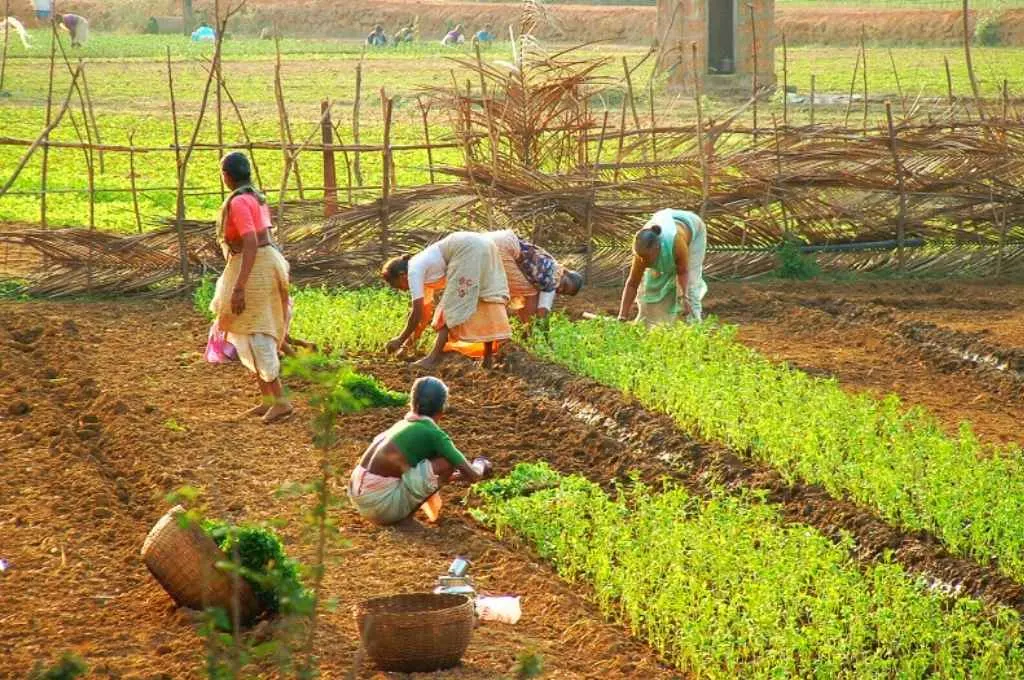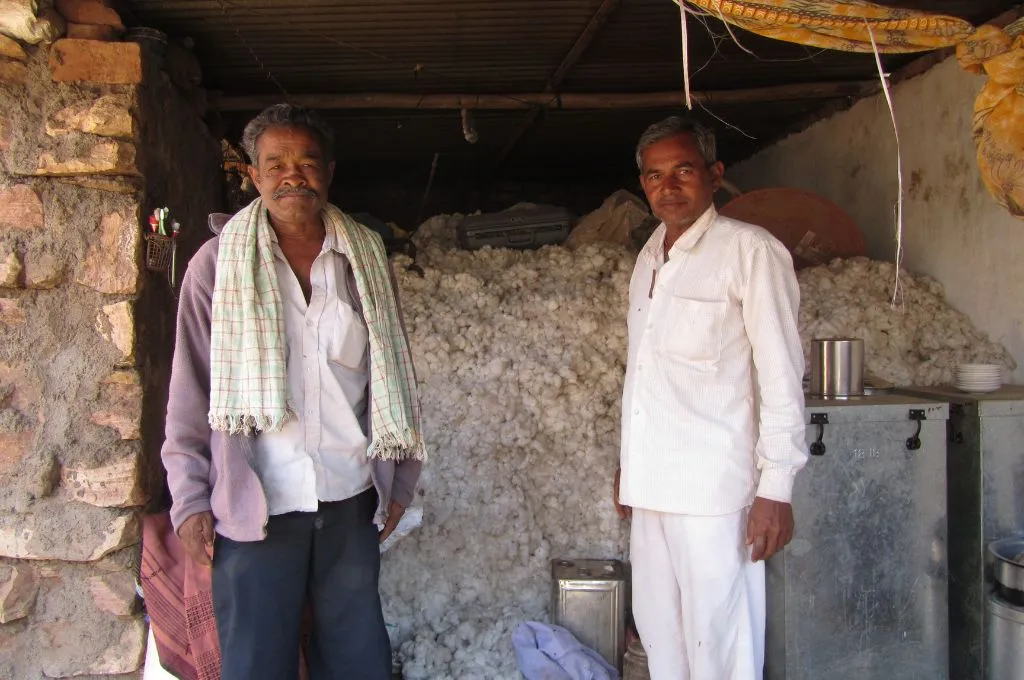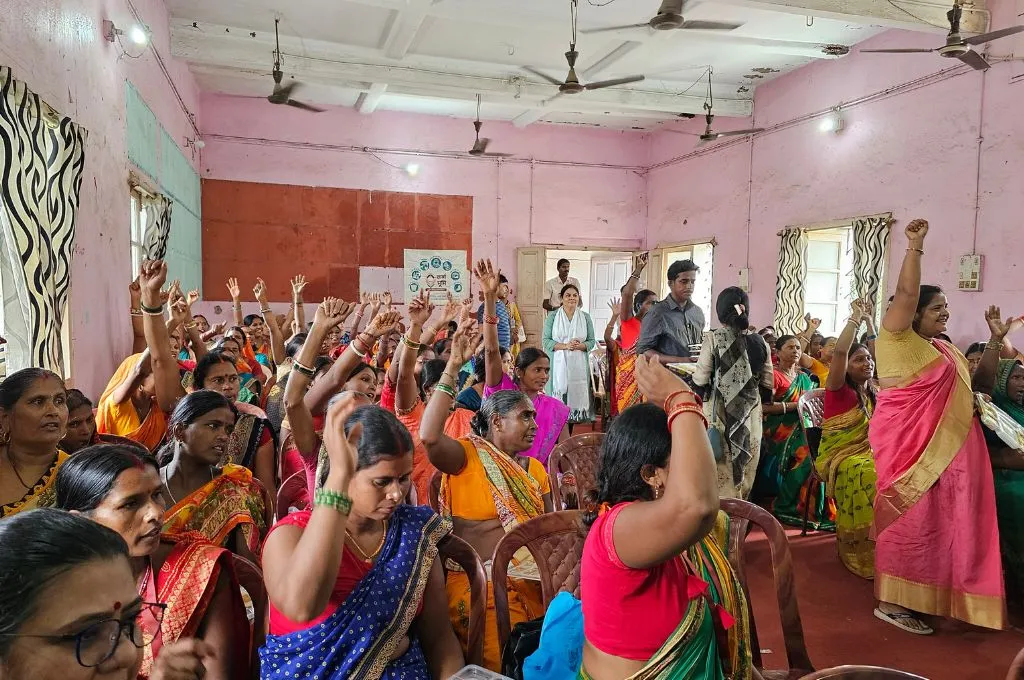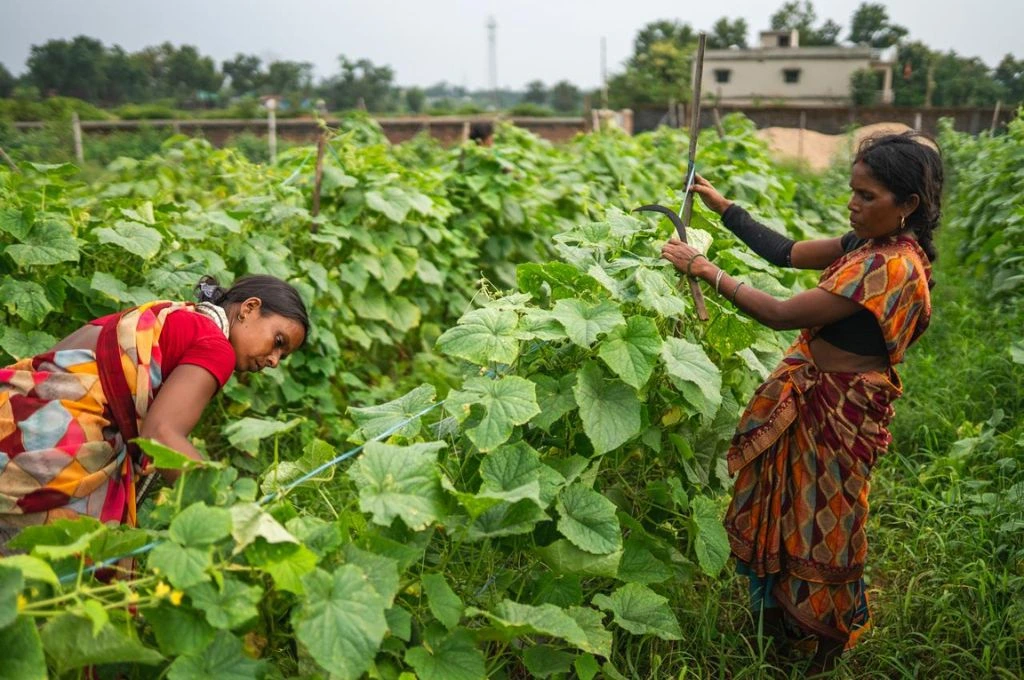When we picture a farmer in India, the image is almost always of a man standing tall in a field, sickle in hand, tilling the soil. But the reality of agriculture in this country is very different: a majority of farm work is carried out by women. Approximately 80 percent of all economically active women are employed in the agriculture sector and approximately 40 percent of the agricultural workforce is women.
These women work on their family land, as daily wage labourers, and in looking after livestock, making them the backbone of our food systems. Yet their role in agriculture largely remains invisible and policies rarely take them into account. But while we fail to acknowledge or value their work, can we really imagine a world in which women stop farming? Can we even exist in a world where women are not involved in agricultural production?
On our podcast On the Contrary by IDR, we spoke with Ireena Vittal, one of India’s most respected independent consultants and advisers on emerging markets, agriculture, and urban development, and Kavitha Kuruganti, activist and founder-convener of Alliance for Sustainable and Holistic Agriculture, about the role women play in India’s agriculture.
Below is an edited transcript that provides an overview of the guests’ perspectives on the show.
Indian agriculture is driven largely by women
Kavitha: There is probably no woman who is not a worker, and no rural woman who is not associated, at least peripherally, with agriculture. Among women counted as workers by our official data systems, at least 73 percent (as per the latest figures) are engaged in agriculture, [whether as] self-employed [farmers], casual labourers, [or] agricultural labourers. We are talking about a very important category of workers in agriculture—women.
Except for some gendered roles that are thrust on men, most of the work, such as transplanting, harvesting, weeding, and sowing, is done by women. Indian agriculture is driven mostly by women putting in their labour. And Indian rural women are largely surviving off agriculture. It is almost a symbiotic relationship. Agriculture needs women farmers and women farmers need agriculture.
Ireena: We’re not talking of the 30–40 million rich farmers who use a lot of labour. We’re talking about the 100 million where the woman provides the labour. [In India,] 35–38 percent [of agriculture] is livestock. Livestock in this country, whether it is dairy, poultry, or fish farming, is completely handled by women. Amul’s cooperative movement in Gujarat, for instance, demonstrated that as the hygiene of the animal was improved, so did hygiene of the family and children. And there’s research that shows that because women led this work, the overall hygiene of villages improved. In the livestock sector, nothing would happen if the women were not involved. Even in rich households with six to 10 milch animals, the mental ownership of the animals is always with the woman.

Policies overlook farmers, especially women
Ireena: When it comes to agriculture policy, the government has three mindsets.
- The first concerns the price of agriculture produce versus inflation. The price [paid by] the consumer is the margin of the farmer. But our government focuses a lot more on inflation management than on ensuring the right price for the farmer. And at the drop of a hat, prices will be reduced because the consumer price index (CPI) should not go [up]. The CPI is the calculation of inflation, and India is one of the few countries where 50 percent of the weightage of inflation is food. So, we ourselves have created a monster.
- The second mindset is food security versus the business of agriculture. We are so fixated on food security—we still haven’t gotten over the Bengal famine or the Green Revolution—that we are not able to recognise that agriculture is actually a business. It is the single largest private business in the Indian economy—it’s 14–16 percent of the GDP. Even if I take dairy, which is one component of it, it is as large as the country’s largest manufacturing sector: automobiles. But nobody thinks of farming as a business. We think of it as food security.
- The third mindset is subsidy versus investment. Worldwide, agriculture is subsidised not because farmers are poor but because they are taking a risk on behalf of all the citizens. Who runs a business where you depend on a pest not [attacking] your crop, or a hailstorm not happening 10 days before you the harvest? Our farmers take the biggest risks of all. And therefore, everybody subsidises agriculture. Even the most open market in the world, the EU, has one sector subsidised: agriculture. So, it’s not that we don’t need to subsidise it, [but] that we also need to invest in R&D, capital, and supply chain. But we don’t have this mindset and frame it as subsidy versus investment rather than subsidy and investment.
A lot of our policy decisions are driven by these mindsets much more than thinking of agriculture as a vibrant sector run by entrepreneurs on behalf of the country while taking risks. [Nor does policy] focus on nutrition, driving investment, and most importantly, balancing the need for profitability with the need for managing inflation for the average person.
Kavitha: I believe that nutrition security has a solution in agriculture, and policymakers ought to be oriented towards that. Similarly, solutions for resource regeneration on a very large scale—and we’re talking about natural and productive resources that form the very basis of the livelihoods of crores of people in this country—largely lie in agriculture. So resource regeneration must be addressed through agriculture. Climate change, both in terms of mitigation and adaptation, [must also be addressed through] agriculture. All of these are issues that any policymaker ought to be thinking about. But unfortunately, what we have—both in [central] government and state policies—are related to the fact that the government thinks about the agricultural sector as one more, almost irrelevant, part of the economy. The government must think about people and the planet when it thinks about agriculture. There is a heavy consumer bias, which reflects a policy-[level] ignorance of [the fact] that most of our consumers are actually producers. This dichotomy of [seeing] consumers [only] at the end of a supply chain is, to this day, not true in India. The hungriest and most malnourished are participating in the food production process. Agriculture is one of the riskiest private enterprises. Nothing is in the control of farmers, not even the land. The government ought to be looking at reducing risks, but it is not doing it. Most importantly, it is not looking at who is invisible among the producers, and therein come women farmers.
Women are pushing back
Ireena: A lot of people who work in agriculture, whether it’s agri-economists or scientists, know that women work. If you speak to any poultry integrator or dairy owner, he will talk to you again and again about women. This is a bigger social question of ‘Do women have rights and do they get acknowledged?’ and it goes back to the age-old issue of who wants to give up power. And unfortunately or fortunately, power is never given; it is taken.
Pradan had been doing remarkable work with groups of poultry women farmers for over two decades. When we visited these women, they were preparing for their annual trip to Bhopal. Every year, hundreds of them would board five buses and spend two days walking up and down the road where the state legislature sits. I asked why they did this, and it cost them nearly two lakhs at the time. They told me: “When we walk in Bhopal, people know we have arrived. The District Magistrate (DM) knows, sometimes even Shivraj Chauhan comes out to meet us. And when we return, the local administration knows we were in Bhopal.”
These were women poultry farmers who had decided to build a voice for themselves, something far easier said than done. But over time, with both capital and capability, they did. And this was 10–12 years ago, women who had never studied, whose daughters were now in school. After 30 years of Pradan’s work, their collective turnover had grown to nearly ₹100 crore.
In retrospect, this story is easy to tell. If you’re a lone woman or you’re part of one SHG in the middle of some state, it’s difficult. It’s about power dynamics and economics. And that change will take some more time, and I think that’s what we need to do.
Kavitha: I see glimpses of great hope, and there are moments of despair too. Even in terms of policy discourse, things have changed. If you look at this great 14-volume report on doubling farmers’ incomes in India, the agriculture extension–related volume [contains some] extremely progressive things about women farmers are. The entire shift underway in Andhra Pradesh through the Andhra Pradesh Community Managed Natural Farming programme is happening on the strength of women’s collectives. If you dip into the experiences of Deccan Development Society [in Telangana], or Anandi as well as the Working Group for Women and Land Ownership (a network organisation) in Gujarat, you can see that how women are organising themselves to assert their identity as farmers. There are quite a few things that they are able to change in these areas. So there is hope. We’ve got to collectively keep alive the visibility of women farmers and their enormous contribution, and not let the world forget it. This will be done by the women farmers themselves by finding a voice and space to articulate it, but also many others supporting the struggle.
The overall economy runs on the unpaid, unvalued, and unremunerated work of women. When we visualise annadata (food provider), it’s really the woman who’s feeding you from the kitchen as well as toiling in the farm. And I can’t imagine farming happening without women.
Recognising women farmers can reshape agriculture
Ireena: First of all, if we were to recognise the labour of women, the price of food would go up, because we would account for the cost for this labour. If you’re a rich farmer paying for migrant labour, you would account for the cost; but when it’s a woman, you don’t. And this is equally true in poultry and dairy, and in horticulture, where so much of the work is done by women. So, first, it would cost labour. But the second thing is that if you accounted for the cost of this labour, whether the woman labourer got paid or not, she would have agency. And a woman who has agency starts building assets and changing the balance sheet of a family. Again, [this is true] much more for the 100 million small farmers than for the 30–40 million rich ones. So, some kind of intergenerational wealth accumulation will start happening.
Kavitha: If policymaking changed to acknowledge that women farmers do matter, I think two broad things will happen.
[The first] is certainly that the women themselves will be empowered in numerous ways. There are studies that show that [since] new-age farmer producer organisations (FPOs)—which are being created with much fanfare—are being gender-blind, [they are] increasing the disparity between male and female farmers in a village. But if policies were designed as though women mattered, food crops, polycropping, and so on would come back into farming. Because a woman would naturally try to make life easier for herself, in order to perform roles that have been thrust on her.
The [second] aspect is that the paradigm of farming will change significantly. And that includes better pricing for food as well as a nurturing of natural resources. Eco-feminists argue that women tend to have a world view and ethos that is different from men. Especially when you thrust them into a market paradigm, there is a certain perspective that they bring which is not similar to men’s. There are studies that show that when women farm together, profitability is actually higher compared to family farming, where a man and a woman farm together.
You can listen to the full episode here.
—
Know more
- Learn more about the systemic barriers that impact women farmers.
- Learn how women farmers in Andhra Pradesh are helping the transition to sustainable farming.
- Read more about Punjab’s Dalit women farmers who do not own land.





